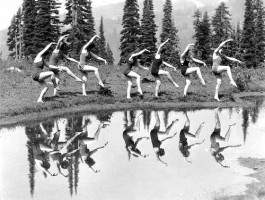
When it comes to talking about dance, there are plenty of possibilities.
Sometimes using “real-life” synonyms to the “dancer speak” that we are accustomed to allows kids to see how big ideas relate from discipline to discipline.
Dance in the public schools provides an outlet for kids to express themselves but also a way to connect the ideas being developed in their core classes in unique ways. Yet, you don’t have to teach in the public schools to work this way.
The education experts tell us that the best way for kids to learn and retain information is to make it meaningful. I tend to be in the camp of Howard Gardner, the mastermind behind the Theory of Multiple Intelligences, who says groupings of ideas might be more important than singular concepts in separate subject areas.
In this way, it makes sense to follow the development of a thought, an evolution if you will, to see how and where ideas connect and enhance meaning.
Here is an example:
In a colleague’s early elementary class, they read a poem about “Reflection”. In this, they were phonetically examining –tion, and how it is used in many words.
When she asked how I would work with reflection, I described that it could start with mirroring movement and that would lead, in my class, to a discussion of opposition– one person’s right hand is their mirror’s left.
From there, in dance, it would lead to symmetry and balance. Since her class is also working on the equal sign not meaning “answer” but meaning “balance”, another possibility for meaningful connections was introduced.
Balance, in my class, is achieved by use of oppositional forces helping us stand, move, and sustain a balance. In other words, we need energy to be sent equally up as well as down, side to side, and so on. This was a clear time to introduce technical movement and the mechanics of how to find one’s balance.
From there, the students could create a “T” chart onto which they listed the information that would help them balance their bodies in dance.
They could also list the way these attributes make them feel as they are practicing balancing, leading to narration.
Perhaps we could even divide the students into opposing camps of whose narratives described an easy balance or a difficult one…..oh, there are so many possibilities for further development.
Through this example, though, you can see that with just a few shared terms, multiple disciplines were taught (English Language Arts, Math, and Science) and ideas were mastered. We could have even discussed dance as a cultural tool thus engaging Social Studies, as well.
What To Do If You Don’t Have a Colleague Driving the Conversation?
- Think broadly about what we do. How might you categorize movement vocabulary? Stationary, axial, uni-lateral or contra-lateral,…..
- Think about ways that we describe movement apart from the French term and supporting definition. What kinds of ideas do these descriptions relate to?
- Ask your students what big ideas are milling around in their minds.
Let the Kids Drive the Conversation
- Create a “What If” Wall to which the students can finish the sentence, posing problems to be figured out through movement.
- Prompts help to push class conversation. “What if you weren’t afraid of anything…What would you try?” Several of my students said they would try to fly. Now that is something we could use some basic partnering to explore!
We could talk about dance in technical terms, think of dance from a scientific approach, and build our class community all at the same time.
Win, win, win.
Earlier in the month, Nichelle wrote an article about the benefit and the bitterness of using dance terminology in “Saut de What? Avoiding Terminology Wars With Your Students”.
How do you talk about dance?
Heather Vaughan-Southard MFA, is a choreographer, dance educator, and performer based in Michigan. She currently directs the dance program at the Everett High School Visual and Performing Arts Magnet in Lansing. With the philosophy of teaching dance as a liberal art, Ms. Vaughan-Southard collaborates with numerous arts and education organizations throughout the state. She has danced professionally in Chicago, Detroit, Los Angeles, and New York and has performed works by Mia Michaels, Lar Lubovitch, Donald McKayle, Billy Siegenfeld, Alexandra Beller, Debra Levasseur-Lottman, and Bob Fosse. As a choreographer, her work has been credited by the Los Angeles Times for “creating heat.” She has recently choreographed for the dance programs at Michigan State University, Grand Valley State University, Lansing Community College and is the former dance professor at Albion College. She is a regular guest artist and blogger for Dance in the Annex, an innovative dance community in Grand Rapids. Heather received her MFA in Dance from the University of Michigan, BFA in Dance from Western Michigan University and K-12 certification in Dance from Wayne State University. Read Heather’s posts.

